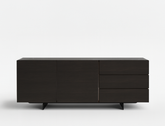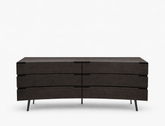Create a Mindful Home through Design

Have you ever stepped into a room and felt an instant wave of calm, even if you couldn’t pinpoint why? Or perhaps you’ve been in a space that sparked your creativity, buzzing with an unspoken energy. These are not random occurrences. They result from the intentional use of space psychology within home interior design and renovation.
Space psychology is the subtle art of creating environments that resonate with human emotions and behaviors. In every corner, piece of furniture, and shade on the wall, there lies a design that affects your mental and emotional state. Whether it's the arrangement of your favorite armchair or the soft hue of your curtains, these choices work together to evoke specific feelings. As you explore the concept of space psychology, you’ll understand how powerful it can be when applied to your HDB or any home. Let’s delve into how space psychology can transform the way you approach home and living interior design and renovation.
What is Space Psychology?
Think of space psychology as the intersection of design and human emotion. Just as a potter shapes clay or a painter mixes colors, designers craft spaces to evoke particular moods, whether it’s relaxation, productivity, or even social interaction. While space psychology is not a new concept, it has gained prominence in the modern age of interior design.
Space psychology delves into how a room “feels” and why certain design elements make us feel a certain way. It taps into the psychology of the human brain, understanding how we perceive space, light, colors, and even furniture arrangements. This concept is especially critical in urban living spaces like Singapore’s HDB flats, where every square foot must be designed with intention.
The Origins of Space Psychology
Our ancestors didn’t design their homes with modern interior design theories in mind. Yet, they were instinctively aware of how their surroundings impacted their emotions and well-being. Fast forward to today, and that basic understanding has evolved into a comprehensive theory known as space psychology.
This field bridges the gap between architecture, psychology, and interior design, emphasizing that good design is not just about aesthetics—it's about how spaces make us feel. As our homes have become multi-functional spaces in fast-paced, urban environments, especially in places like Singapore, the role of space psychology has grown more essential. Today, it influences every aspect of home design, from furniture choices to the layout of a room.
Why Space Psychology Matters in Home Interior Design
Singaporean homes, particularly HDB flats, are more than just shelters; they are sanctuaries, workspaces, and social hubs. The importance of space psychology in interior design becomes even more pronounced in this context. By integrating space psychology, homeowners can create spaces that not only look stunning but also feel uplifting and nurturing.
When designing a home, space psychology encourages a holistic approach. It considers not just the physical layout but also the emotional and psychological needs of the people who will live in that space. For example, the colors, lighting, and placement of furniture in a room can profoundly affect a person’s mood. Warm tones like yellows and reds can evoke feelings of warmth and social interaction, while cool tones like blues can promote relaxation.
The way furniture is arranged also impacts how a space feels. A cramped, cluttered living room may cause anxiety, while an open, well-lit room can create a sense of calm and clarity. Space psychology offers practical tools for designing interiors that encourage positive emotional responses, such as joy, comfort, and peace.
Key Principles of Space Psychology
1. Colors and Their Psychological Impact
Colors have a direct influence on our moods and emotions. For instance, bright colors like red and orange are known to increase energy levels, making them ideal for social spaces like living rooms or dining areas. Cooler colors like blue and green, on the other hand, are calming and are often used in bedrooms to create a peaceful environment.
Incorporating colors that align with the purpose of each room can significantly enhance the overall atmosphere of your home. Whether it’s using soft pastels in a cozy nook or bold hues in a social space, understanding the psychology of color can transform how you experience your living environment.
2. Natural Light and Space
Natural light is one of the most important aspects of space psychology. Sunlight doesn’t just illuminate a room—it lifts the mood, increases productivity, and even improves sleep. Spaces with ample natural light tend to feel more inviting and comfortable.
Maximizing the natural light in a home, especially in small HDB flats, can make a room feel larger and more open. Incorporating light-reflective surfaces like mirrors, glass, and lighter shades in furniture and decor can further enhance this effect.
3. Furniture Placement and Room Layout
Furniture placement is crucial in determining how a room feels and functions. A well-designed layout guides the flow of movement and encourages certain behaviors. For instance, arranging seating in a circular or U-shape encourages conversation and social interaction. In contrast, placing furniture against the walls can make a room feel more spacious but might hinder close interactions.
In small spaces like HDB flats, optimizing furniture placement can make all the difference between a cramped environment and one that feels open and functional.
How to Apply Space Psychology in Your Home Renovation
1. Optimizing Space in HDB Flats
Space is often a premium in Singaporean homes, so using space psychology to maximize every inch is essential. Begin by decluttering your living spaces. A minimalist approach to furniture can help open up even the smallest rooms, creating a sense of freedom and calm. Choose multifunctional furniture pieces like extendable dining tables or storage beds, which offer both functionality and aesthetics.
2. Incorporating Emotional Design
Every piece of furniture in your home should serve an emotional purpose. A plush sofa with soft fabrics invites relaxation, while sleek, modern chairs may inspire productivity in a home office. When selecting furniture, consider how it will make you feel each time you use it.
3. Creating Focal Points
A focal point is an element in a room that draws attention and anchors the space. In living rooms, this might be a statement sofa or a unique coffee table. In bedrooms, a bold bed frame can serve as the centerpiece. Focal points give rooms structure and help guide the flow of movement.
FAQs on Space Psychology and Home Design
How does interior design impact our emotions? Interior design directly affects our emotions by influencing how we perceive and interact with space. Elements like colors, lighting, and furniture arrangement can evoke specific feelings—whether it’s comfort, relaxation, or energy. A well-designed space enhances well-being, while poorly designed interiors can cause stress and discomfort.
Can space psychology improve productivity at home? Yes, space psychology can significantly improve productivity, especially in home offices. By selecting the right colors, lighting, and furniture placement, you can create an environment that fosters focus and creativity. Natural light, minimal distractions, and ergonomic furniture are key factors that boost productivity.
What are some simple ways to apply space psychology in small spaces? In small spaces, prioritize functionality and simplicity. Choose multifunctional furniture that saves space, use light colors to create the illusion of openness, and ensure that natural light flows freely. Decluttering and using strategic storage solutions can also help make a small space feel more comfortable and organized.
Conclusion: Transforming Your Home Through Space Psychology
Space psychology offers a roadmap for creating homes that don't just look beautiful but also feel emotionally nurturing. By understanding the subtle ways that furniture placement, colors, and lighting affect our emotions, you can create a home that is both functional and harmonious.
For those looking to bring space psychology into their home design, Prestige Affairs Furniture offers a wide selection of pieces that perfectly balance style and function. Whether you’re looking for a statement sofa or a sleek coffee table, the right furniture can help you craft an environment that promotes well-being and comfort. Explore the collection today to start transforming your home into a haven of peace, creativity, and joy.







